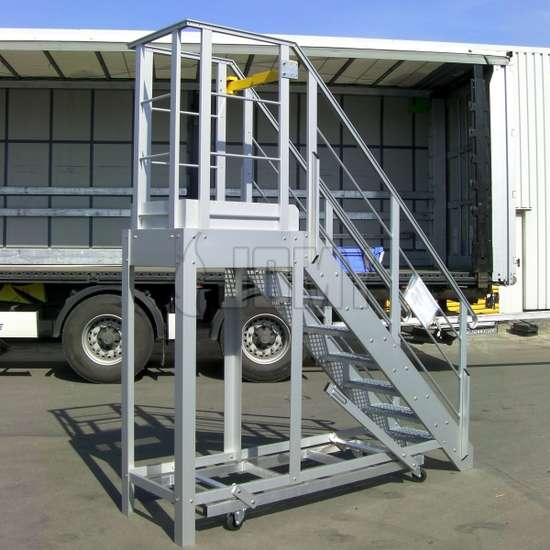
Work platforms are crucial tools for various industries, enabling professionals to safely and efficiently access elevated workspaces. From construction and painting to electrical work and maintenance, these platforms provide a stable base for completing tasks at heights. This article delves into the different types of work platforms, their applications, safety considerations, and factors to ponder when choosing the right platform for your needs.
Types of Work Platforms:
- Step ladders: These versatile platforms offer a compact solution for low-rise tasks. They typically have two to four steps and a platform with guardrails.
- Scaffolding: When dealing with extensive or complex projects requiring access to multiple heights, scaffolding provides a modular and adaptable solution.
- Scissor lifts: These self-propelled platforms elevate workers and materials vertically using scissor-like mechanisms, offering excellent stability and reach.
- Boom lifts: Articulating boom lifts provide exceptional horizontal and vertical reach, making them ideal for tasks like window cleaning, tree trimming, and overhead installations.
- Mobile elevating work platforms (MEWPs): Combining features of scissor lifts and boom lifts, MEWPs offer superior maneuverability and versatility for diverse applications.
- Workstation platforms: These stationary platforms are often used in industrial settings for assembly, welding, and other tasks requiring prolonged work at elevated heights.
Applications of Work Platforms:
The applications of work platforms are vast, spanning numerous industries and tasks:
- Construction: From erecting walls and installing roofs to painting and electrical work, work platforms provide safe access to various construction phases.
- Maintenance: Tasks like cleaning windows, inspecting equipment, and repairing infrastructure often require elevated access, which work platforms facilitate safely.
- Events and entertainment: Setting up lighting, audio, and rigging for events often necessitates reaching heights safely, where work platforms come in handy.
- Film and photography: Camera operators and photographers frequently use work platforms to capture unique angles and aerial shots.
- Arboriculture: Tree trimming, branch removal, and other tree care activities often involve working at heights, making work platforms essential tools.
Safety Considerations:
Using work platforms responsibly is paramount to ensuring worker safety. Here are crucial safety considerations:
- Choose the right platform for the job: Consider factors like weight capacity, reach, and terrain when selecting a platform.
- Inspect the platform before use: Check for damage, loose parts, and proper functioning of mechanisms.
- Follow manufacturer instructions: Ensure all users are trained on the safe operation and limitations of the platform.
- Use fall protection: Utilize harnesses, lanyards, and guardrails as per regulations and best practices.
- Maintain awareness of surroundings: Be mindful of overhead hazards, electrical lines, and uneven surfaces.
Choosing the Right Work Platform:
Selecting the appropriate work platform requires careful consideration of various factors:
- Task requirements: Consider the specific needs of the task, including height, weight capacity, and maneuverability.
- Work environment: Evaluate factors like terrain, weather conditions, and space constraints.
- Budget: Compare different platform options and their associated costs to find the most cost-effective solution.
- Regulations: Ensure the chosen platform complies with relevant safety regulations and industry standards.
By understanding the different types of work platforms, their applications, safety considerations, and selection criteria, you can make informed decisions to ensure efficient and safe work at heights.
Work Platforms: Frequently Asked Questions
What type of work platform do I need?
The best platform for your needs depends on several factors, including:
- The height you need to reach: Step ladders are suitable for low-rise tasks, while boom lifts offer superior reach for high work.
- The weight you need to support: Choose a platform with a capacity exceeding your intended load.
- The terrain and workspace: Consider maneuverability and stability based on the work environment.
- Regulations and budget: Ensure compliance with safety standards and find a platform that fits your budget.
What are the safety considerations when using a work platform?
Always prioritize safety:
- Inspect the platform thoroughly before each use.
- Choose the right platform for the job, considering weight capacity and reach.
- Follow manufacturer instructions for safe operation and limitations.
- Utilize fall protection equipment like harnesses, lanyards, and guardrails.
- Maintain awareness of surroundings, including overhead hazards and uneven surfaces.
What are the benefits of using a work platform?
- Increased safety: Platforms minimize fall risks and provide a stable work surface.
- Improved efficiency: Reaching elevated workspaces is faster and easier with platforms.
- Versatility: Platforms cater to various tasks and industries, from construction to maintenance.
- Ergonomics: Working at comfortable heights reduces fatigue and strain.
Where can I rent or purchase a work platform?
Numerous equipment rental companies offer various platforms for your needs. Additionally, manufacturers and distributors also sell platforms directly.
Do I need training to use a work platform?
Training is crucial for operating work platforms safely and effectively. Familiarize yourself with manufacturer instructions, and consider seeking formal training courses from qualified professionals.
What are the legal requirements for using a work platform?
Regulations vary depending on your location and industry. Research and comply with all relevant safety regulations and standards for work platform usage.
How can I maintain my work platform?
Regular inspections, proper maintenance, and following manufacturer recommendations are key to ensuring the safety and longevity of your work platform.
